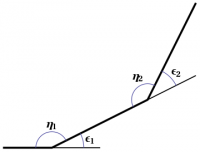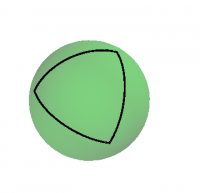- §1. Curves
- §2. Surfaces
- §3. Examples in 3D
- §4. Curvature
- §5. Curvature in 3D
- §6. Components
- §7. Bianchi Identities
- §8. Geodesic Curvature
- §9. Geodesic Triangles
- §10. Gauss-Bonnet Thm
- §11. The Torus
Geodesic Triangles
What is the total curvature around a closed curve? Using the definition in the previous section, if we integrate the geodesic curvature around any closed curve we have \begin{equation} \oint \kappa_g\,ds = \oint d\alpha - \oint \omega^1{}_2 = 2\pi - \oint \omega^1{}_2 \end{equation} since $\TT$ must return to its original orientation. We can now use Stokes' Theorem on the last term, which tells us that \begin{equation} \oint \omega^1{}_2 = \int d\omega^1{}_2 \end{equation} where the integral on the right is over the interior of the curve. Furthermore, recall that \begin{equation} \Omega^1{}_2 = d\omega^1{}_2 = K\,\omega \end{equation}
where $K$ is the Gaussian curvature and $\omega$ the orientation of $\Sigma$. Putting this all together, we obtain \begin{equation} \int K\,\omega + \oint \kappa_g\,ds = 2\pi \label{gb1} \end{equation}
What if the curve is only piecewise smooth? Then the integral around the curve will not pick up the discrete jumps in $\alpha$ at the corners. In this case ($\ref{gb1}$) becomes \begin{equation} \int K\,\omega + \oint \kappa_g\,ds = 2\pi - \sum \epsilon_i = 2\pi - \sum (\pi - \eta_i) \label{gb2} \end{equation} where $\epsilon_i$ is the exterior angle at the $i$th corner, namely the angle through which the tangent vector rotates at that corner, and $\eta_i$ is the corresponding interior angle, as shown in Figure 1.
An immediate application of ($\ref{gb2}$) is a formula for geodesic triangles on a sphere, for which $\kappa_g=0$ and $\int K\,\omega$ gives the the area of the triangle divided by the square of the radius $a$. Thus, the area $A$ of a geodesic triangle on a sphere is given by \begin{equation} \frac{A}{a^2} = 2\pi - \sum (\pi - \eta_i) = \sum\eta_i - \pi \label{areasph} \end{equation} where the sum runs from $i=1$ to $i=3$. The area of such a triangle is therefore proportional to the angle excess of the triangle, that is, the amount by which the sum of the interior angles exceeds $\pi$. This argument also shows that the sum of the angles in a geodesic triangle on a sphere always exceeds $\pi$. An example is shown in Figure 2.
In the plane, $K=0$, and the same argument reduces to the fact that the angle sum of a triangle in the plane is always $\pi$.
Spacelike hyperboloids $x^2-t^2=-a^2$ in (two-dimensional) Minkowski space provide a model for hyperbolic geometry, in which the Gaussian curvature is constant but negative. A similar argument to that given above for spheres leads again to (\ref{areasph}), but with a minus sign on the left-hand side; the area of hyperbolic triangles is proportional to the angle deficit.

